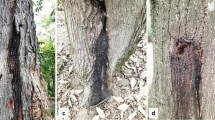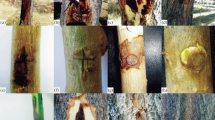Abstract
A bacterial disease of walnut (Juglans regia) has been observed in northwestern Iran during the summer of 2018 with symptoms similar to the shallow bark canker on trunks and branches. In the present study, two hundred and thirty-six obtained isolates were characterized and classified into three major groups based on the biochemical and physiological characters. With the species-specific primer pairs, Brenneria rubrifaciens was not detected, and a few isolates were recognized as B. nigrifluens. The partial 16S rDNA sequences and multilocus sequence analysis based on housekeeping genes gyrB, rpoB, infB, and atpD following a phylogenetic analysis revealed that the isolates are belonged to B. roseae subsp. roseae, B. nigrifluens and Gibbsiella quercinecans (190 out of 236 isolates) species. Iranian isolates formed the monophyletic clades and had high sequence similarity with the relative type strains. The pathogenicity tests of G. quercinecans, B. roseae subsp. roseae and B. nigrifluens isolates on branches and trunks of 5-year-old walnut trees indicated that they had effective potential to cause necrosis and canker on branches. The effective identification of potentially pathogenic bacterial species associated to the canker disease of walnut trees was confirmed using species-specific primer pairs and concatenated partial sequences of housekeeping genes. Further investigation is necessary to determine the agents might be involved in the etiology of the disease.




Similar content being viewed by others
Data availability
The 16S rDNA- Housekeeping genes sequences are available from GenBank with accession numbers:
(16S rDNA) MN822728, MN822729, MN822730, MN822731, MN822732, MN822733, MN822734, MN822735, MN822736, MN822737, MN473259, MN473260, MN473261, MN822900, MN822901, MN822902, MN822903, MN822904, MN822905, MN822906, KF308291.
(gyrB) MN841613, MN841614, MN841615, MN841616, MN841617, MN841618, MN841619, MN841620, MN473071, MN473072, MN473073, MN841650, MN841651, MN841652, MN841653, MN841654, MN841655, MN841656, JX425084, KF308303, JF311612.
(infB) MN841621, MN841622, MN841623, MN841624, MN841625, MN841626, MN841627, MN841628, MN473074, MN473075, MN473076, MN841657, MN841658, MN841659, MN841660, MN841661, MN841662, MN841663, JX425213, KF308313, JF311725.
(atpD) MN841605, MN841606, MN841607, MN841608, MN841609, MN841610, MN841611, MN841612, MN473068, MN473069, MN473070, MN841643, MN841644, MN841645, MN841646, MN841647, MN841648, MN841649, JX424954, KF308293, JF311499.
(rpoB) MN841635, MN841636, MN841637, MN841638, MN841639, MN841640, MN841641, MN841642, MN841602, MN841603, MN841604, MN841664, MN841665, MN841666, MN841667, MN841668, MN841669, MN841670, JX425340, KF308323, JF311837.
(recA) MN841629, MN841630, MN841631, MN841632, MN841633, MN841634.
References
Allahverdipour, T., Shahryari, F., & Falahi Charkhabi, N. (2020). First report of walnut bacterial canker caused by Gibbsiella quercinecans and Brenneria roseae subsp. roseae in Iran. New Disease Reports, 41, 12–12.
Amirsardari, V., Sepahvand, S., & Madani, M. (2017). Identification of deep bark canker agent of walnut and study of its phenotypic, pathogenic, holotypic and genetic diversity in Iran. Journal of Plant Interactions, 12, 340–347.
Bakhshi-Ganje, M., Shams-Bakhsh, M., Mackay, J., & Rahimian, H. (2020). Identification and characterization of bacterial strains associated with diseased oak trees in northern Iran. Forest Pathology, 50(1), e12571.
Bakhshi-Ganje, M., Mackay, J., Nicolaisen, M., & Shams-Bakhsh, M. (2021). Comparative genomics, pangenome and phylogenomic analyses of Brenneria spp., delineation of Brenneria izadpanahii sp. nov. Phytopathology, 111, 78–95.
Brady, C., Cleenwerck, I., Venter, S., Vancanneyt, M., Swings, J., & Coutinho, T. (2008). Phylogeny and identification of Pantoea species associated with plants, humans and the natural environment based on multilocus sequence analysis (MLSA). Systematic and Applied Microbiology, 31(6–8), 447–460.
Brady, C., Hunter, G., Kirk, S., Arnold, D., & Denman, S. (2014). Description of Brenneria roseae sp. nov. and two subspecies, Brenneria roseae subspecies roseae ssp. nov and Brenneria roseae subspecies Americana ssp. nov. isolated from symptomatic oak. Systematic and Applied Microbiology, 37(6), 396–401.
Brady, C., Denman, S., Kirk, S., Venter, S., Rodríguez-Palenzuela, P., & Coutinho, T. (2010). Description of Gibbsiella quercinecansgen. Nov., sp. nov., associated with acute oak decline. Systematic and Applied Microbiology, 33(8), 444–450.
Coenye, T., Falsen, E., Vancanneyt, M., Hoste, B., Govan, J. R., Kersters, K., & Vandamme, P. (1999). Classification of Alcaligenes faecalis-like isolates from the environment and human clinical samples as Ralstoniagilardii sp. nov. International Journal of Systematic and Evolutionary Microbiology, 49(2), 405–413.
Denman S, Brady C, Kirk S, Cleenwerck I, Venter S, Coutinho T, & Vos P.D (2012). Brenneria goodwinii sp. nov., associated with acute oak decline in the UK. International Journal of Systematic and Evolutionary Microbiology, 62, 2451–2456.
Denman, S., Brown, N., Kirk, S., Jeger, M., & Webber, J. (2014). A description of the symptoms of acute oak decline in britain and a comparative review on causes of similar disorders on oak in Europe. Forestry, 87(4), 535–551.
Doonan, J., Denman, S., Pachebat, J. A., & McDonald, J. E. (2019). Genomic analysis of bacteria in the acute oak decline pathobiome. Microbial Genomics, 5(1).
Dauga, C. (2002). Evolution of the gyrB gene and the molecular phylogeny of Enterobacteriaceae: A model molecule for molecular systematic studies. International Journal of Systematic and Evolutionary Microbiology, 52, 531–547.
Ebrahimi, S., Jamei, R., Nojoomi, F., & Zamanian, Z. (2018). Persian walnut composition and its importance in human health. International Journal of Enteric Pathogens, 6(1), 3–9.
Edwards, U., Rogall, T., Blöcker, H., Emde, M. & Böttger, E. C. (1989). Isolation and direct complete nucleotide determination of entire genes. Characterization of a gene coding for 16S ribosomal RNA. Nucleic Acids Research, 17(19), 7843–7853.
Falahi Charkhabi, N., Shams-bakhsh, M., & Rahimian, H. (2010). Genetic diversity among Brenneria nigrifluens strains in Iran. European Journal of Plant Pathology, 128(3), 303–310.
FAO. (2019). FAOSTAT statistical database. In Publisher: FAO (food and agriculture Organization of the United Nations). Italy.
Glaeser, S. P., & Kämpfer, P. (2015). Multilocus sequence analysis (MLSA) in prokaryotic taxonomy. Systematic and Applied Microbiology, 38(4), 237–245.
González, R., López-López, M. J., Biosca, E. G., López, F., Santiago, R., & López, M. M. (2002). First report of bacterial deep bark canker of walnut caused by Brenneria (Erwinia) rubrifaciens in Europe. Plant Disease., 86, 696. https://doi.org/10.1094/PDIS.2002.86.6.696B
Harighi, B., & Rahimian, H. (1997). Wide spread occurrence of the bark canker of walnut trees in Mazandaran Province. Iranian Journal of Plant Pathology, 33(3/4), 48–50.
Li, Y., Zheng, M. H., Wang, H. M., Lin, C. L., & Wang, X. Z. (2019). Brenneria corticis sp. nov., isolated from symptomatic bark of Populus× euramericana canker. International Journal of Systematic and Evolutionary Microbiology, 69(1), 63–67.
Lopez, M. M., Marti, R., Morente, C., Orellana, N., Ninot, T., & Aleta, N. (1994). Bacterias fitopatogenas identificadas en nogal en España. InstitutoNacional de Investigaciony Tecnologia Agraria y Alimentaria.
Loreti, S., De Simone, D., & Gallelli, A. (2008). Detection and identifcation of Brenneria nigrifluens, the causal agent of the shallow bark canker of walnut by, PCR amplifcation. Journal of Phytopathology, 156(7–8), 464–469.
McClean, A. E., Sudarshana, P., & Kluepfel, D. A. (2008). Enhanced detection and isolation of the walnut pathogen Brenneria rubrifaciens: Causal agent of deep bark canker. European Journal of Plant Pathology, 122, 413–424.
Ménard, M., Delort, F., Baudry, A., & Le Saux, M. (2004). First report of bacterial canker of walnut caused by Brenneria nigrifluens in France. Plant Disease, 88(2), 220–220.
Moradi-Amirabad, Y., Rahimian, H., Babaeizad, V., & Denman, S. (2019). Brenneria spp. and Rahnella victoriana associated with acute oak decline symptoms on oak and hornbeam in Iran. Forest Pathology, 49(4), e12535.
Moretti, C., & Buonaurio, R. (2010). Immature walnut fruit inoculation for evaluation of Brenneria nigrifluens pathogenicity. Phytopathologia Mediterranea, 49(1), 80–83.
Moretti, C., Silvestri, F. M., Rossini, E., Natalini, G., & Buonaurio, R. (2004). Diagnostic tools for the identification of Brenneria nigrifluens, the causal agent of Persian walnut bark canker. Journal of Plant Pathology, 86(4), 300–301.
Niemann, S., Pühler, A., Tichy, H. V., Simon, R., & Selbitschka, W. (1997). Evaluation of the resolving power of three different DNA fingerprinting methods to discriminate among isolates of a natural Rhizobium meliloti population. Journal of Applied Microbiology, 82(4), 477–484.
Nylander, J. A. (2004). MrModeltest v2 (Program distributed by theauthor, Evolutionary Biology Centre, Uppsala University, Uppsala, Sweden).
Schaad, N. W., Jones, J. B., & Chun, W. (2001). Laboratory guide for the identification of plant pathogenic bacteria (no. Ed. 3). American Phytopathological society (APS Press); p. 373.
Soutar, C. D., & Stavrinides, J. (2020). Phylogenetic analysis supporting the taxonomic revision of eight genera within the bacterial order Enterobacteriales. International Journal of Systematic and Evolutionary Microbiology, 70(12), 6524–6530.
Soylu, S., Kara, M., Bozkur, I. A., Soylu, E. M., Kurt, S., & Uysal, A. (2020). First report of bacterial shallow bark canker of walnut (Juglansregia) caused by Brenneria nigrifluens in Turkey. Journal of Plant Pathology, 103, 333. https://doi.org/10.1007/s42161-020-00661-9
Thapa, S. P., Lim, C. K., Kim, S. K., Cho, J. M., Hur, J. H., & Park, D. H. (2010). Direct detection of Brenneria rubrifaciens by PCR-based assay using rubrifacine synthetic gene. African Journal of Microbiology Research, 4(16), 1754–1757.
Tamura, K., Stecher, G., Peterson, D., Filipski, A., & Kumar, S. (2013). MEGA6: Molecular evolutionary genetics analysis version 6.0. Molecular Biology and Evolution, 30(12), 2725–2729.
Vahdati, K., MohseniPourtaklu, S., Karimi, R., Barzehkar, R., Amiri, R., Mozaffari, M., & Woeste, K. (2015). Genetic diversity and gene flow of some Persian walnut populations in southeast of Iran revealed by SSR markers. Plant Systematics and Evolution, 301, 691–699.
Wilson, E. E., Stake, M., & Berger, J. A. (1957). Bark canker, a bacterial disease of the Persian walnut tree. Phytopathology,47(11).
Wilson, E. E., Zeitoun, F. M., & Fredrickson, D. L. (1967). Bacterial phloem canker, a new disease of Persian walnut trees. Phytopathology, 57, 618–621.
Yousefikopaei, F., Taghavi, S. M., & Banihashemi, Z. (2007). Occurrence of shallow bark canker of walnut (Juglans regia) in southern provinces of Iran. Pakistan Journal of Biological Sciences, 10(9), 1507–1512.
Acknowledgments
We would like to thank Dr. Taghavi from Shiraz University for kindly gifting a B. nigrifluens strain and Dr. BakhshiGanje from Plant Protection Research Department, Kohgiluyehva Boyer-Ahmad Agricultural and Natural Resources Research and Education Center, AREEO, for providing chemical material support.
Author information
Authors and Affiliations
Contributions
Tohid Allahverdipour contributed to the acquisition of data, performed of the data analyses, interpretation of data and drafting of the manuscript, Fatemeh Shahryari was responsible for supervising the work, conception, design, interpretation of data and revision of the manuscript, Nargues Falahi Charkhabi was advisor this work and contributed to the revision of the manuscript.
Corresponding author
Ethics declarations
Ethical approval
This research does not contain any studies with human participants or animals performed by any of the authors.
Informed consent
Informed consent was obtained from all individual participants included in the study.
Conflict of interest
The authors declare that they have no conflict of interest.
Rights and permissions
About this article
Cite this article
Allahverdipour, T., Shahryari, F. & Falahi Charkhabi, N. Gibbsiella quercinecans and Brenneria roseae subsp. roseae associated to the canker disease of walnut trees in northwestern Iran. Eur J Plant Pathol 161, 783–797 (2021). https://doi.org/10.1007/s10658-021-02359-9
Accepted:
Published:
Issue Date:
DOI: https://doi.org/10.1007/s10658-021-02359-9




